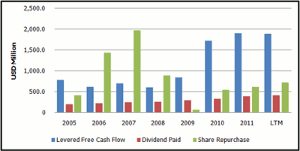Usually investors get very excited when the companies they invest in buy back their stock...but if you analyze the reasons for the buybacks, you may find that they aren't always the best use of excess corporate cash, especially for income investors, notes Jim Trippon of Dividend Genius.
On the face of it, stock buybacks look like good things. After all, the company is investing its cash in the company itself. If that isn’t a vote of confidence, what is?
The company usually repurchases outstanding shares and retires them. Investors then own a larger stake proportionately in the company, and that includes things like a larger portion of earnings. The market often reacts to stocks which announce buybacks by pushing up the share price.
These can be good strategic moves for companies, particularly those that have excess cash. Investing in the company itself can strengthen shareholders’ investment, and this is often considered the best use for cash.
Contrast this with companies that have squandered their capital with bad acquisitions, often on businesses that don’t mesh with their core business, which can seriously affect the value of the company and the worth of the shareholders’ investment.
Are Buybacks Always A Good Thing?
But what about when share buybacks either don’t work or are not even the best use of a company’s capital? After all, shareholders are interested in the best return for their investment.
For dividend investors, which can include anyone from pure income-only investors to those investors who buy shares in stocks of companies that provide a combination of yield and capital appreciation, the share buyback—particularly if it’s instead of a dividend or in lieu of dividend growth—can be a less attractive alternative.
The most notable scenarios when stock buybacks aren’t good for investors are when the company buys shares to spin its financial results. Very simply, when shares are bought and retired, there are fewer shares outstanding, so earnings per share improves. Of course, it improves without actual improvement in the business, or net income, as it’s just a way of tweaking the financial arithmetic to make things look better.
All the financial numbers calculated on a per-share basis, such as cash flow per share and so on, look better, but of course they aren’t. The obvious financial engineering not only fails to improve the business’ fundamentals, but after a while, even this won’t help lower and lower earnings.
|pagebreak|Not only is the cash not going, for example, to dividend investors via a dividend increase, but there’s another less obvious reason for buybacks: to prop up share value for executive compensation. With many executives receiving significant compensation in the form of stock options, the buyback artificially inflates the EPS and pumps up the value of the options.
Again, meanwhile, the shareholder, hungrily awaiting a dividend or a dividend increase—actual, tangible cash, gets the short end of this deal, in this case nothing.
Buying Back Overvalued Shares
Another maddening aspect of the stock buyback, even if it’s executed otherwise as a reasonable way of deploying the company’s cash in a fundamentally healthy, growing company, is when a company executes its stock repurchase program at unfavorable prices.
One of the otherwise excellent companies that’s done this is Costco Wholesale (COST), which purchased far fewer shares in their stock buyback program in 2009 when its share prices were lower, compared to buying back more shares more recently at a higher price.
Another otherwise good company that’s done something similar is 3M (MMM). After the severe market break in 2009, it effectively nearly ceased buying back the shares it had been repurchasing before the crisis.
Buybacks resumed in force after 2009, but a problem was the share price, which bottomed at nearly $40 during the financial crisis, eventually rose back to the $80 to $90 range. So the buybacks were executed at higher share prices rather than lower ones.
While investors and companies can disagree which approach is better for dividend investors, there is probably a bias toward value. That is, the company’s fundamentals are paramount, so the financial engineering and gimmicky buybacks should be met with due scorn.
When a shareholder receives a dividend, he or she has the option of reinvesting it, saving it, or spending it on something else entirely. It’s real, actual cash in hand. Most investors, and particularly dividend investors, prefer this.
If companies such as Coca-Cola (KO), which grows its earnings and revenue solidly over time, pays a steady, growing dividend, and want to add share buybacks into the mix, as it has successfully done, then that’s a combination most investors will happily accept.
Subscribe to Dividend Genius here...
Related Reading:
Stock Spinoff Creates Safety, Growth...and More DRIPs












